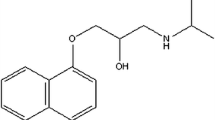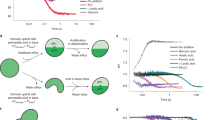Abstract
The colloid osmotic nature of the cell lysis can be prevented by adding osmotic protectants of appropriate sizes to the outer medium. We introduced inorganic and organic electrolytes as protectants to determine the precise channel sizes of the polyene antibiotics, amphotericin B and nystatin, in addition to the sugars so far widely used for this purpose. Because colloid osmotic cell lysis is evidenced by the loss of membrane permeability barriers for small sizes of ions, such as K+, preceding hemolysis, we firstly simultaneously monitored the time response of the K+ efflux and hemolysis induced by amphotericin B by combining a fiber-optic spectrometer with a K+-selective electrode. Based on this experiment, we evaluated the sizes of channels of the polyene antibiotics formed in the erythrocyte membrane using the radii of hydrated ions calculated from a modified Stokes’ law, as well as the radii of sugars. The radii of channels formed by amphotericin B and nystatin were found to be in a very narrow range of 0.36 - 0.37 nm. Similar experiments were performed using calcein-loaded liposomes containing cholesterol or ergosterol, and the radii of channels formed in these liposomal membranes were also found to be the same as when formed in an erythrocyte membrane. The present results demonstrated that introducing the sizes of hydrated ions can afford a more precise channel size than the use of sugars alone.
Similar content being viewed by others
References
T. Katsu, C. Ninomiya, M. Kuroko, H. Kobayashi, T. Hirota, and Y. Fujita, Biochim. Biophys. Acta, 1988, 939, 57.
L.-M. Chi and W.-G. Wu, Biochim. Biophys. Acta, 1991, 1062, 46.
M. Moayeri and R. A. Welch, Infect. Immun., 1994, 62, 4124.
J. Brajtburg, G. Medoff, G. S. Kobayashi, S. Elberg, and C. Finegold, Antimicrob. Agents Chemother., 1980, 18, 586.
T. Katsu, Biol. Pharm. Bull, 1999, 22, 978.
T. Houdai, S. Matsuoka, N. Matsumori, and M. Murata, Biochim. Biophys. Acta, 2004, 1667, 91.
R. A. Robinson and R. H. Stokes, “Electrolyte Solutions,” 1959, Butterworths. London, 118.
T. Katsu, T. Imamura, K. Komagoe, K. Masuda, and T. Mizushima, Anal. Sci., 2007, 23, 517.
S. G. Schultz and A. K. Solomon, J. Gen. Physiol, 1961, 44, 1189.
R. Scherrer and P. Gerhardt, J. Bacterial., 1971, 107, 718.
T. Katsu, H. Kobayashi, and Y. Fujita, Biochim. Biophys. Acta, 1986, 860, 608.
T. Katsu and K. Nakashima, Analyst, 1999, 124, 883.
R. B. Gennis, “Biomembranes,” 1989, Springer-Verlag, New York.
B. A. Wallace, BioEssays, 2000, 22, 227.
T. Katsu, M. Kuroko, T. Morikawa, K. Sanchika, Y. Fujita, H. Yamamura, and M. Uda, Biochim. Biophys. Acta, 1989, 983, 135.
E. F. Gale, in “Macrolide Antibiotics. Chemistry, Biology and Practice” ed. S. Omura, 1984, Academic Press, New York, 425.
J. Bolard, Biochim. Biophys. Acta, 1986, 864, 257.
A. Tossi, L. Sandri, and A. Giangaspero, Biopolymers, 2000, 55, 4.
Y. Shai, Biopolymers, 2002, 66, 236.
A. Knopik-Skrocka, J. Bielawski, M. Glab, A. Klafaczynska, and M. Wulkiewicz, Cell. Mol. Biol. Lett., 2003, 8, 439.
R. R. C. New, in “Liposomes: a Practical Approach,” ed. R. R. C. New, 1990, IR. Press, Oxford, 105.
W. Tomisato, K. Tanaka, T. Katsu, H. Kakuta, K. Sasaki, S. Tsutsumi, T. Hoshino, M. Aburaya, D. Li, T. Tsuchiya, K. Suzuki, K. Yokomizo, and T. Mizushima, Biochem. Biophys. Res. Commun., 2004, 323, 1032.
D. J. Woodbury and C. Miller, Biophys. J., 1990, 58, 833.
Author information
Authors and Affiliations
Corresponding author
Rights and permissions
About this article
Cite this article
Katsu, T., Okada, S., Imamura, T. et al. Precise Size Determination of Amphotericin B and Nystatin Channels Formed in Erythrocyte and Liposomal Membranes Based on Osmotic Protection Experiments. ANAL. SCI. 24, 1551–1556 (2008). https://doi.org/10.2116/analsci.24.1551
Received:
Accepted:
Published:
Issue Date:
DOI: https://doi.org/10.2116/analsci.24.1551




